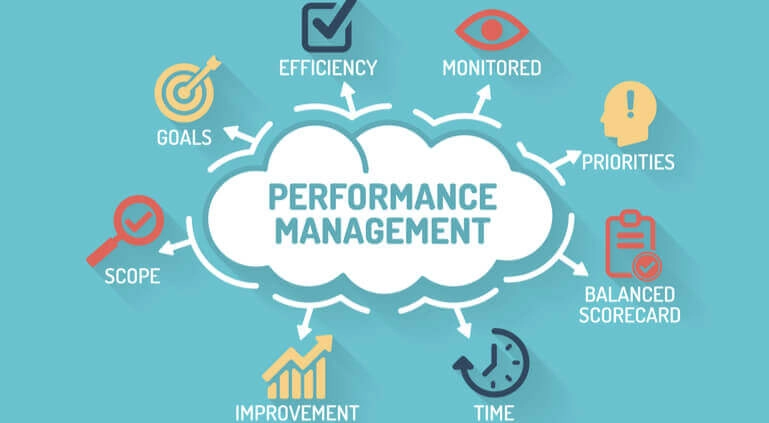In the not too distant past, corporate entities were run in a traditional way, part of which involved appraising staff from time to time to assess their input, output, and productivity with respect to organizational goals. The system then employed was cumbersome and time-consuming.
This state of affairs made organizations realize the need for changes in their approach to employee management. The resulting restructuring that ensued led to the evolution of a system that increased organizational effectiveness and employee productivity in a very drastic manner.
Thus, performance management systems were born.
Statistics About Modern Performance Management Systems
- 80% of the youthful generation wants instant gratification rather than a formal review: An annual review leaves a 12-month gap during which period outstanding achievements would have been forgotten due to the passage of time.
- 90% of performance reviews are emotionally and mentally distressing: The intense focus put on recent events and often discouraging feedback damages the person’s self-confidence. A threatening situation like this actually impairs the individual’s brain function according to research carried out on the brain.
- Only 5% of HR leadership find performance reviews satisfactory: In actual fact, 95% of managers are displeased with long-established performance management customs.
- 51% of employees are of the opinion that annual reviews are grossly inaccurate: Considering the preponderance of events that occur within a space of 6 months to a year, it may not be out of place to say annual reviews may be irrelevant in this regard. A singular review cannot adequately capture and cover all angles fairly. Consequently, such reviews tend to be incorrect, prejudiced, and demotivating to staff.
- Overview of Performance Management System
- Definition
- Purpose
- Types
- Stages
- Implementation
- Components
- Benefits
- Disadvantages
What is a Performance Management System?
A performance management system is a continuous methodical process by which the human resources arm of a company makes personnel participatory in advancing the effectiveness of the company, by achieving the stated vision, mission, and objectives of the organization.
Performance management encapsulates key human resource functions like frequent communication, employee training for improved performance, acknowledgment of good work, presentation of benefits for improved performance, goal-setting, continuous progress review, and real-time feedback.
What is An Effective Performance Management System?
An effective performance management system is one in which the following are done:
- The performance management cycle is continuous and not annual
- Leadership, executive, and upper-level management buy-in to performance management has been secured
- Making certain verbal performance exchanges and reviews are significant and not just routine
- Verifying your managers, are both willing and capable of delivering result-oriented performance management on a daily basis
- Utilizing user-friendly performance management software that grants you visibility of performance management activity
Purpose of a Performance Management System
- To improve the company profit margin: Performance management improves business performance by reducing staff turnover which helps to boost the company profit margin thus generating great business results.
- To guide personnel along a suitable career path: In line with best practices worldwide for performance management, personnel in a supervisory role are expected to guide the staff under them along a clearly defined and progressive career route.
- To furnish staff with valuable progressive feedback: Prompt real-time feedback makes performance management systems run by HR more engaging and proactive.
- To ensure staff attains their SMART goals: Company staff can only attain goals set for them and surpass expectations when they are absolutely clear about what exactly is expected of them. Goals that are regularly set, that are short-term, and which are frequently discussed are often more effective.
- To ensure employee goals relate to and advance organizational objectives: Human resources employ performance management systems to aid staff in seeing the nexus between their individually assigned goals and the overall organizational strategy. This gives the meaning and purpose employees seek in their careers.
Types of a Performance Management System
- General Appraisal: A constant interaction between the manager and employee all year round.
- 360-Degree Appraisal: Feedback from employees about other employees.
- Technological Performance Appraisal: Evaluation of an employee’s technical proficiency.
- Employee Self-Assessment: Employee’s self-appraisal as compared with that of his direct line manager.
- Manager Performance Appraisal: Evaluation of the manager involving feedback from both the team and clientele.
- Project Evaluation Review: Appraisal to ascertain the level of an employee’s expertise on the job.
- Sales Performance Appraisal: Judgment of a salesperson’s goals versus results obtained via targets met.
Performance Management System Stages
Plan:
- Reach a consensus on SMART goals
- Generate a private development plan
- Re-assess personnel’s job description and revise the role profile where required
-
Act:
- Attain set objectives
- Execute role
- Put into effect personal development plans
-
Track:
- Frequently monitor progress made
- Get regular feedback
- Counter obstacles
- Instruct and guide
-
Review:
- Re-evaluate accomplishments
- Pinpoint lessons learned
- Deliberate on career objectives
- Concur on future action steps
-
Implementing a Performance Management System
Undoubtedly, a modern performance management system helps to improve the individual productivity of a team. However, the key to achieving that is proper implementation. These are ways you can implement a performance management system:
- Clarify expectations: Clearly state in specific terms the output and attitudes expected of employees.
- Observe and Assist Performance: Watch attentively as the plan is put into action and intervene where and when necessary to ensure compliance.
- Evaluate Performance: Assess outcomes and/or behavior in the process of task execution.
- Interact and Positively Review: Discuss performance, share observations, request for employee feedback, and jointly innovate on how to improve in the future.
-
What are the Components of a Performance Management System?
- Setting goals: Setting realistic goals for employees inspires them to strive to achieve better results which impact positively on the company’s overall productivity. This is because individual goals should be aligned with departmental goals which in turn should be a subset of organizational goals.
- Planning: The qualities and degree of expertise the employee should develop in order to meet objectives are set out for him or her. These objectives form part of the organizational strategy.
- Communication and collaboration: A good performance management system aids in building an atmosphere of free open ongoing communication about the team, tasks assigned, and challenges encountered. Constant communication motivates the team, keeps everyone on the same page and makes you proactive.
- Performance evaluations: These are regular short term ‘check-ins’ to assess how well an employee is performing on tasks or assignments allocated to him or her. Allows for mid-course correction when deviations are detected.
- Performance reviews: These reviews which can be annually or quarterly, allow the staff first to self-evaluate themselves before supervisors rate their performance. In recent times the introduction of 360-degree evaluation has greatly enhanced the process and increased team productivity.
- Good performance recognition: A critical aspect of a performance management system is the recognition and reward for high performers. This creates an atmosphere of fair play and a level playing field within the organization.
- Feedback: This component of a performance management system gives you the opportunity to point out personnel areas of weakness, room for improvement, and strategies on how to achieve it. Such employees are more likely to be productive than those not exposed to this process.
- Learning and Development: Active learning and development which is an integral part of a performance management system should be promoted aggressively. It should be ongoing and will help staff attain their performance potential.
Advantages of a Performance Management System
- Improved consistency: A performance management system is designed with a carefully selected set of parameters suited to the company’s stated objectives. This system is equally applicable to and cuts across all departments giving rise to a consistent set of expectations required to be met on the part of the employee.
- High performers and training: It is a versatile means of objectively recognizing great talent and determining training requirements per time.
- Effectiveness of training: A training program’s degree of effectiveness can easily be ascertained from the level of growth and development in organizational staff.
- Motivation boost for employees: It is an avenue to encourage staff by celebrating their wins.
- Employee retention: A key metric of a performance management system is seeing to the satisfaction and fulfillment of employees which automatically results in retention.
- Saving time: The process which is procedural and has stages gives rise to feedback which can lead to a mid-course correction. This saves both management and the company precious time which could have been lost due to errors only discovered at an advanced stage.
- Full performance reviews: This gives an overall impression which is often very accurate, about the true position of things on the ground with respect to employee interpersonal relationships.
- Performance appraisal fairness: The objective and structured manner in which an appraisal document is prepared to serve to create a level playing field for all staff as numerous factors are taken into consideration.
- Automated performance reviews: The advent of human resource-related software has greatly helped to automate the process.
What are the Disadvantages of a Performance Management System?
- Inconsistency: Busy schedules can make us lose focus, recall only negative aspects and not acknowledge the high points of employees under us consistently.
- Prejudice: Human frailty makes it near impossible to keep out bias from the process; only a structured objective process can mitigate or eliminate this.
- Time Consuming: It is very tedious drafting out documentation having to do with employee appraisals considering the number of employees and key points to be captured in the document.
- Discouragement: If the undue emphasis is placed only on areas where employees fell short the tendency is for them to be discouraged and give in to despair. It is best to include and reinforce positives also, notable achievements, and progress.
Frequently Asked Questions
Q.What is the difference between a performance management system and a performance measurement system?
A. Performance measurement refers to the quantitative indicators used to monitor progress made against strategy put forward. This encompasses criteria like:
- People Measures
- Customer Measures
- Financial Measures
- Process Measures
-
Performance measurement essentially determines how you track the progress of the strategy put in place.
Performance management on the flip side deals with managing the strategy put in place.
Q.What is a continuous performance management system?
A. In a human resources context, it refers to performance management processes that take place all year round on an ongoing basis as against traditional annual appraisals.
Q.What changes will employees see with the new process?
A. Below are the changes which employees are expected to see:
- Increased independence and autonomy for employees
- Instant communication
- Improved professional relationships
- Transparency in process implementation
-
Q.What should you consider when choosing a performance management system?
A. Following are the points that you should consider:
- Standalone or suite: This should be determined by the business requirements of the organization.
- Customization: It is appropriate that you ensure that whatever system is purchased and deployed is tailored to specifically address problems that have been identified in that particular organization.
- Usability: User-friendly systems with a brief learning curve must be given top priority to ease the work of managers.
- Budget: Every organization is run on a budget. Consequently, the manager in charge must do a fine balancing act of keeping within the confines of budgetary constraints of his organization while at the same time procuring a package that addresses identified needs as comprehensively as possible.
-
Final Thoughts
It is clear beyond a shadow of a doubt that performance management systems are critical for business success. An organization in today’s modern business world that must remain relevant, competitive and growth-oriented must harness the awesome power embedded in this system.
Related Articles:
7 Essential Employee Performance Management Tools to Use
5 Performance Management Problems and How to Solve Them
Top 10 Performance Appraisal Methods to Boost Productivity in 2019
Performance Appraisal Systems in HRM: 6 Types
Tips for an Effective Employee Performance Appraisal Process Flowchart







